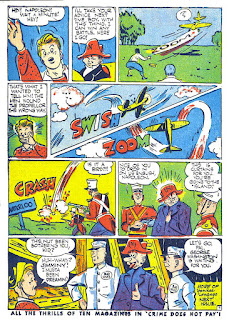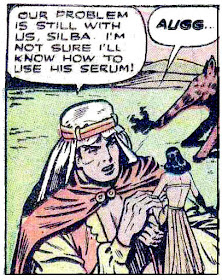News that Mad magazine is being cancelled should not be surprising news, because the magazine business is not as it once was. All I can say is, so long, Mad, it’s been good to know ya.
I believe Mad, which had plenty of imitators, was always the best of the bunch, but there were still some of the imitations I liked, including this comic from Atlas. They threw some of their best artists into their versions of Mad, hoping to cash in. Years ago I showed the contents of a 1956 issue of Riot, with Severin, Maneely and Everett. Just click on the thumbnail.
Monday, September 30, 2019
Friday, September 27, 2019
Number 2394: Captain Video vs A.I.
Growing up in the fifties, besides comic books I read a lot of science fiction. Some of that science fiction (as well as comic books) used robots. Sometimes the robots were smarter than the people in the story. Sometimes they wanted to take over from humans. I was able to assure myself that it was all just fiction. Nowadays I worry about the near-future when robot cars share the road. The funny thing about fiction is that sometimes it turns into fact.
Captain Video and his ranger meet up with some smart robots who have killed their creator, and are in the process of taking over. Since comic books are produced by humans and not robots the prejudice is for the flesh and blood guys and not the artificial guys.
The television program, Captain Video, was on the air for a few years from the now long defunct Du Mont Network. Du Mont also manufactured televisions, as you can see here with this luxurious 1951 model.
Because of their money problems the television productions were low budget, including Captain Video, where it would be obvious when they were cutting corners with the futuristic stuff, like space helmets. The satire from Mad #15, “Captain TVideo,” drawn by Jack Davis, points out some of the cheap props. Did they actually use shirt cardboard cut to look like a space helmet? I don’t know, but it’s a funny idea.
At least the story I am showing today is free from budget constraints. No budget for props in a comic book. Whatever a writer can think up and an artist can draw costs the same as any other comic book. “Island of Conquerors” is the last Captain Video story from Fawcett, after six issues in 1951. It is from issue #6 (1951), no writer credited, but drawn by George Evans and Martin Thall.
Captain Video and his ranger meet up with some smart robots who have killed their creator, and are in the process of taking over. Since comic books are produced by humans and not robots the prejudice is for the flesh and blood guys and not the artificial guys.
The television program, Captain Video, was on the air for a few years from the now long defunct Du Mont Network. Du Mont also manufactured televisions, as you can see here with this luxurious 1951 model.
Because of their money problems the television productions were low budget, including Captain Video, where it would be obvious when they were cutting corners with the futuristic stuff, like space helmets. The satire from Mad #15, “Captain TVideo,” drawn by Jack Davis, points out some of the cheap props. Did they actually use shirt cardboard cut to look like a space helmet? I don’t know, but it’s a funny idea.
At least the story I am showing today is free from budget constraints. No budget for props in a comic book. Whatever a writer can think up and an artist can draw costs the same as any other comic book. “Island of Conquerors” is the last Captain Video story from Fawcett, after six issues in 1951. It is from issue #6 (1951), no writer credited, but drawn by George Evans and Martin Thall.
Wednesday, September 25, 2019
Number 2393: “You used to be so amused at Napoleon in rags...”
I don’t know when the cliché of mental illness in the form of a Napoleon delusion started, but I am using this Yankee Longago story published in Boy Comics #7 (1942) as an example of a simplistic and jokey view of mental illness in days past. Things we cannot understand or explain we sometimes turn into a joke, don’t we?
“Yankee Longago” was an entertaining series about a boy who seemed to be unstuck in time (to use Kurt Vonnegut’s expression); he was apt to end up anywhere at any point in history, meeting famous people. In this episode he is in France with Napoleon; the real Napoleon, not the delusional Napoleon he first encounters. Yankee even tried to intercede with the real Napoleon, warning him not to invade Russia. No luck.
At the end Yankee is back in his time — or did he just wake up from a dream? — to see orderlies from the “Bug House” picking up the ersatz Napoleon an orderly calls “this nut.” Sigh. We all had a lot to learn in that time, from then until now, and it has been a slow process.
Story and art by Dick Briefer.
“Yankee Longago” was an entertaining series about a boy who seemed to be unstuck in time (to use Kurt Vonnegut’s expression); he was apt to end up anywhere at any point in history, meeting famous people. In this episode he is in France with Napoleon; the real Napoleon, not the delusional Napoleon he first encounters. Yankee even tried to intercede with the real Napoleon, warning him not to invade Russia. No luck.
At the end Yankee is back in his time — or did he just wake up from a dream? — to see orderlies from the “Bug House” picking up the ersatz Napoleon an orderly calls “this nut.” Sigh. We all had a lot to learn in that time, from then until now, and it has been a slow process.
Story and art by Dick Briefer.
Monday, September 23, 2019
Number 2392: Master Key’s penetrating ray
Master Key, a creation of the Harry “A” Chesler publishing company, doesn’t wear a costume. He sticks to his dapper civilian wardrobe. Master Key, also known as Ray Cardell, was zapped through a telescope by some oddball ray, and it gave him the power of x-ray vision and also the power to zap people with that ray. Ray and his ray, you might say.
This episode, from Scoop Comics #2 (1942) has the usual set of spies trying to do in the hero. They make the mistake many villains make. They create a deathtrap. When exactly, in movies or serials or pulps or comic books does a deathtrap work? Never, I think.
No credits from the Grand Comics Database for an artist or writer.
This episode, from Scoop Comics #2 (1942) has the usual set of spies trying to do in the hero. They make the mistake many villains make. They create a deathtrap. When exactly, in movies or serials or pulps or comic books does a deathtrap work? Never, I think.
No credits from the Grand Comics Database for an artist or writer.
Friday, September 20, 2019
Number 2391: The cop and the kid and the Blonde Phantom
Wikipedia says of the Blonde Phantom: “Louise Grant, born in Hoboken, New Jersey, was secretary to private detective Mark Mason. Enamored with her boss and wanting to help him break cases, she surreptitiously donned a black domino mask and a sexy, skintight, slit-leg red evening gown and high heels, and ventured out at night fighting crime. Highly athletic and seemingly trained in martial arts, the Blonde Phantom also carried a .45-caliber pistol. In a distaff echo of Superman and Lois Lane, Mason had a crush on the Blonde Phantom, but not on Louise.”
In this story from Blonde Phantom #17 (1948), our heroine and a cop try to help a kid keep out of trouble. Juvenile delinquency was and is a problem. There have always been juvenile delinquents, but in the postwar world they were focused on, and some prominent adult observers blamed comic books for delinquency. It has been the experience in my lifetime that when young people commit crimes some “experts” look to popular culture for blame.
This story has no author listed by the GCD, but the artwork is credited to Syd Shores ? and Vince Alascia ? Those question marks mean the GCD does not know for certain. Nor do I.
Another Blonde Phantom story. Just click on the thumbnail.
In this story from Blonde Phantom #17 (1948), our heroine and a cop try to help a kid keep out of trouble. Juvenile delinquency was and is a problem. There have always been juvenile delinquents, but in the postwar world they were focused on, and some prominent adult observers blamed comic books for delinquency. It has been the experience in my lifetime that when young people commit crimes some “experts” look to popular culture for blame.
This story has no author listed by the GCD, but the artwork is credited to Syd Shores ? and Vince Alascia ? Those question marks mean the GCD does not know for certain. Nor do I.
Another Blonde Phantom story. Just click on the thumbnail.
Wednesday, September 18, 2019
Number 2390: Dagar Desert Hawk: Big Sahib, Little Sahib
I’ll get this out of the way: the villain in this story refers to himself as “Big Sahib.” I looked up sahib in the dictionary. It is a term of respect for greeting someone. An example given is “the Doctor Sahib.” My reason for checking on it is because it is a term from India, not from an Arab country where this story takes place.
Big Sahib is a short guy, so to get bigger he does not choose to buy platform shoes or heel lifts, he just invents a formula to shrink everyone else. Maybe instead of creating a shrink juice he could have worked on a formula to make himself taller?
Jack Kamen drew this story, or at least a substantial part of it, at the Iger Studio. Grand Comics Database credits artist Edmund Good, but I don’t believe it’s by Good, who did draw some Dagar stories, but Kamen. I love Kamen’s action scenes and scantily clad women in this sexy story from Fox Features, the line of exploitation comics.
This short story is from Dagar Desert Hawk #16 (1948).
Big Sahib is a short guy, so to get bigger he does not choose to buy platform shoes or heel lifts, he just invents a formula to shrink everyone else. Maybe instead of creating a shrink juice he could have worked on a formula to make himself taller?
Jack Kamen drew this story, or at least a substantial part of it, at the Iger Studio. Grand Comics Database credits artist Edmund Good, but I don’t believe it’s by Good, who did draw some Dagar stories, but Kamen. I love Kamen’s action scenes and scantily clad women in this sexy story from Fox Features, the line of exploitation comics.
This short story is from Dagar Desert Hawk #16 (1948).




















































